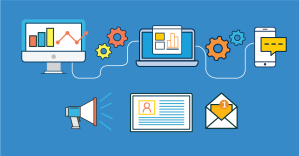Automated marketing communications includes everything from email drip campaigns to scheduled social media posts and customer service chatbots, and all of it has probably made your marketing life much easier. With these systems in place, you can communicate to customers more quickly, save time, and free yourself to do higher level work. There’s just one potential problem: Your customers can see right through generic, boring templates. They want real, authentic communication, and they may jump ship if you rely too heavily on templated responses.
How can today’s marketers take advantage of all the potential that automated marketing offers, while still giving each customer the personal attention and support they crave?
Marketing Automation Isn’t the Future. It’s Now.
If a company isn’t automating communication with its customers, then it’s already behind the marketing curve. Automation, in all its forms, provides marketers with powerful tools that allow them to:
- Introduce themselves to prospects
- Take prospects on a guided buying journey
- Re-engage cold leads
- Increase sales with add-on recommendations and upgrade notifications
- Answer common questions and concerns
- Maintain ongoing visibility
- Strengthen loyalty
What makes automation key is that you can create campaigns that essentially run themselves. For example, let’s say that you own a comedy club. You can put together social media posts featuring all the comedians coming to the club during the next month, with links back to your ticket purchase landing page. You can also set up a series of drip campaign emails for your VIP club members that offer discounted tickets for early purchases. Finally, based on customer feedback, you can hire a marketing company to develop a customer service chat bot that recommends shows, purchases tickets, and handles common customer questions and refunds.
How does marketing automation help drive your marketing?

Once this is all set up, you can just sit back, relax, and let your marketing department basically run itself while your ROI skyrockets, right?
Not so fast. Your customers are savvy individuals, and if you don’t add the personal touch, you may find that your automation schemes don’t attract customers in droves, but leave them feeling bored.
How to Do Marketing Automation All Wrong
You’ve almost certainly been forced to endure the notorious phone-tree tango. You know the one: You need help with an urgent inquiry, call a company, and then spend 15 minutes pressing buttons and enunciating commands at a robotic assistant until you finally get a live person on the phone. The operator quickly fixes your problem with a few keystrokes, but you are left frustrated at all the time you just spent on the phone.
It’s easy to see all the benefits that marketing automation provides. It’s an important part of your marketing mix. However, you must ensure you use it wisely. Marketing automation that isn’t actively monitored and tweaked can take away the personal connection your customers expect and leave them frustrated, just like you are after your phone-tree tango.
For example, you may have an automated customer service email tree. When a customer has a question about a common problem, your system automatically sends a curated response with suggestions. The system saves you loads of time that you would otherwise spend responding to the same low-level questions over and over again. For the most part, your customers appreciate the immediate response. But how does your customer feel after she carefully crafts a long email describing her problem, only to receive a templated answer straight from your FAQ section — which she already checked before emailing you?
Likewise, you don’t want to flood your customers with generic drip campaign emails or fail to respond to their social media comments just because you set your posting schedule at the beginning of the month. Impersonal email messages, wonky chat bots, and no responses on your social media pages are all ways to turn your customers into adoring fans… of your competition.
This doesn’t mean you have to go back to responding to every customer service email personally or spend every waking moment on Twitter in case a customer mentions your company. Instead, here are a few tips on how to use marketing automation without losing the personal touch.
5 Ways to Step Up Your Marketing Automation
- Focus on the customer journey
- Avoid using cookie cutter responses
- Make it easy to see every interaction a customer has had with your company
- Don’t repeat messaging
- Don’t make customers repeat themselves
- Ensure your social profiles are up to date
- Train your employees on a regular basis

Keep Your Voice
Every piece of marketing communication you write, whether it’s a short thank you email for signing up for a mailing list, an Instagram post, or a chat bot response, should retain the character and unique voice of your company. Your comedy club chat bot could use cheesy puns to make your customers smile and maintain the character of your business. Reuben Yonatan, the founder and CEO of GetVoIP, encourages readers to “let your humanness shine; customers want to be reassured that you are invested in helping them.”
Personalize Your Emails
This may seem as obvious as snow in the winter, but take the extra step of personalizing your automated email messages. Use the customer’s first name in the greeting and include their company name in B2B emails. According to research from The Aberdeen Group, personalized email messages increase emails clicks by 14 per cent and conversions by 10 per cent.
Say Goodbye to “Spray and Pray”
Today’s customer relationship management (CRM) platforms offer even the smallest businesses and one-man shops the ability to segment their customers to an intimate degree. If your current communication method is to set up a drip campaign that goes out to your entire customer list — with no segmentation — you’re likely seeing low open rates and higher-than-average unsubscribe rates. For example, your large business clients don’t understand why you’re announcing a promotion on software geared toward startups, and your startup clients aren’t interested when you announce a multi-million dollar equipment upgrade they can’t afford.
You don’t need to — and can’t — market to every single one of your prospects and clients individually. However, you can give them a more personalized communications experience by segmenting them. Segment customers by demographics, behaviour, budget, usage rate, loyalty, buying stage, and more.
Additionally, consider creating automated communications connected to specific transactions, such as:
- Making a purchase
- Putting an item in a cart, and then leaving your site without buying
- Returning an item
- Watching a video
- Reviewing several similar products and leaving your site
- Downloading a white paper
- Using a discount or taking advantage of a promotion
By linking your communications to a specific behaviour, you have a better chance of saying the right thing to the right person at the right time and getting another sale, or, at the very least, showing your customers you care about their unique buyer journeys.
Don’t Ignore Social Media
It can be incredibly time consuming to monitor multiple social media channels all day so you can address customer complaints, acknowledge and share compliments, and respond to customers who are used to companies interacting with them through these channels. However, your silence on these channels can be deafening as well. According to research, most Twitter users expect companies to respond — quickly — to them when they reach out.
How can you keep up with these demanding expectations? The first step is to set up automatic alerts for any social media mentions of your company, product, executive team, and more. Your marketing platform should have this capability. With these alerts in place, assign a member of your team to respond. This person will need training and autonomy to respond quickly, but be clear about what types of messages should be forwarded to members of management for further consideration.
How Social Media Monitoring Works
- In summary, your company or industry is mentioned online, and your social media listening software finds it. The software then analyzes it and routes the comment to what it believes is the best department. That department writes or creates its response in their software and posts it to the appropriate site.

Be Realistic About Your Bots
Chat bots are, essentially, programs designed to interact with customers on your behalf. When you visit a website and see a customer support window pop up with a pleasant message from “Tiffany” offering help, odds are that Tiffany is actually a chat bot.
Currently Facebook Messenger, Slack, and WeChat can all integrate chat bots. In fact, Facebook Messenger claims 100,000 monthly active chat bots on its platform just a year after allowing them.
If you are considering developing a chat bot, or already have one working with your customers, make sure your expectations are realistic. If your bot, for example, can only respond to simple commands, let your customers know its limitations and include an easy way for them to contact a human.
De-Automate When Necessary
Do not make the mistake of valuing your convenience over providing a great customer experience. Marketing automation takes work off your plate, but it is designed to help your marketing department achieve more, not do less. At some point, you and your team need to be available to provide your customers with excellent and personalized service. Carefully evaluate your automated marketing program and make sure there are avenues for customers to reach you directly when needed. You don’t want to lose customers through the 15-minute phone tree.
Finding the balance between implementing automated marketing campaigns and providing your customers with the personalized communications they want isn’t really so hard. Err on the side of better customer service, more personalization, and realistic expectations for what automated templates can achieve. While automation techniques and capabilities will continue to improve over time, at least for the present, great customer service still often requires the human touch.
Learn more about automated marketing in our free Marketer’s Field Guide. 
Share “You Need to Use Templates, But You Must Use Them Well” On Your Site


























